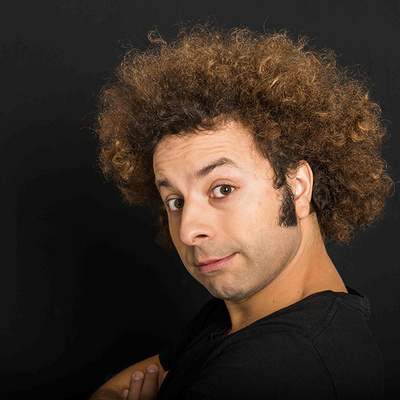CirK2.2: Breakthrough Research Melds Circus with Sound
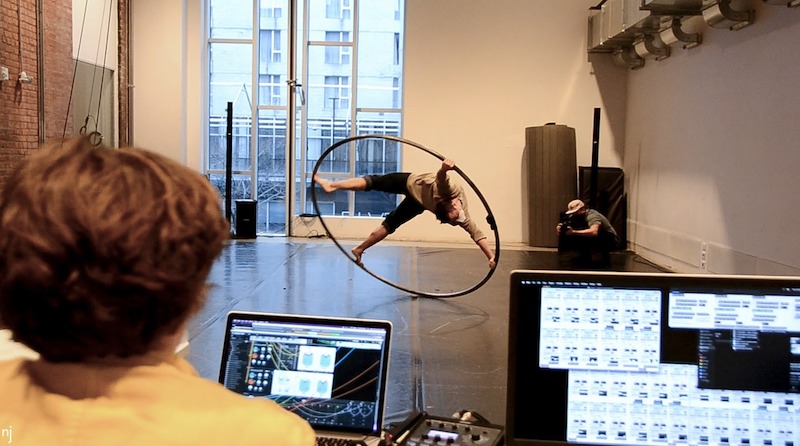
CirK 2.2 is a sound/movement based project I’ve been working on for almost 5 years now. The origin of this project came from a desire to communicate my emotions and my creativity through circus arts but with a particular desire to compose, by myself, the music and sound environment with the only instrument I have, my body. This project was made possible thanks to the financial support of the Conseil des arts et des lettres du Québec.
The intention with this project is to question the circus arts and new technologies, using the movements, acrobatics of the artist and circus props to generate a sound atmosphere.
With the technologies, each movement is translated into a specific sound wave, adjusting to the individual characteristics of each artist and circus discipline. Just like a dancer’s brain generates movement in response to various incoming information such as music, I am using the technologies to reproduce auditory-motor integration but in the opposite direction, so that movements and proprioception will represent the incoming information that will generate sounds, timbres and music.
The intention behind this project is to create a universe where the artist and the circus discipline are an integral part of musical creation. In service of the music, the artist is both the initiator and the creator, through his movements. This innovative approach offers a different treatment of the use of music in the circus arts.
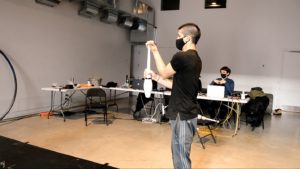
This project establishes a connection, a direct relationship between movement, acrobatics and sounds. With wireless sensors, we are using powerful softwares and algorithms that receive and analyse the sensor’s data which goes through different processes that turn them into sounds. Thanks to a real-time “Feedback”, the music and the artist interact with each other. CirK 2.2 aims to enhance all of the artist’s movements so that each of them can be perceptible by “making” different circus bodily dynamics sing, to the most subtle movements, by giving them “a voice” through sound.
The movements but also the circus accessories “express themselves” using high-performance and interactive technology. With this technology, circus and music are one.
As far as the artist’s experience, Bobby Cookson, Cyr wheel artist who was part of the research, expressed his experience in these words : “My brain shifted from being a circus artist to a musician. In addition to creating with the techniques of Cyr wheel, I found myself just trying to make sounds that flowed from one to another. As far as the feeling while performing goes, it became like playing with a live orchestra, always at your own tempo.”
The idea is to establish a framework where the audience can have a whole new experience and approach to circus. In addition to observing it, they will also be able to hear it, feel it and interact in a completely new way where music is viewed and movement is listened to.
This project creates artistic proposals that go beyond simple circus acts and offers an experience in its own right, bordering on a concert and a circus show with a multi-sensory dimension at the heart of the artistic intention.
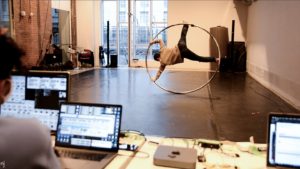
Ruth Wikler, as a spectator, shares her feelings with us “As department head for Circus Arts Programming at TOHU, I have the distinct privilege (even, and especially, during the pandemic!) of experiencing Montréal’s contemporary circus artists and companies’ freshest ideas as they emerge from our creation residencies. No exception is Naël Jammal, a circus artist whose curiosity and imagination are propelling him in fascinating directions. Naël ’s engineering experiment, is not simply a nifty trick. Because Naël ’s sensors can attach to just about any type of sound, this mechanism opens up a new scenic language. Watching his experiment, I thought of the dance world’s Isadora, which was also created by artists, for artists—both projects use technology to expand the realm of what is possible.”
Now that the research has been done for two circus disciplines, there are now two axes of approaches for the next steps. One is to emphasize the work done with a more artistic approach, by working on different sounds, textures and effects to suit the needs of creating proper artitic propostions. On the other end, the research needs to be continued on other circus disciplines and see the potential of this research on them. I’m currently looking for differentspotential partners such as creation residency, funding, collaborators etc… to be able to continue this journey.
I would be more than happy to discuss with you, if you are curious to know more about this project. You can contact me by visiting my profile here.
Project director: Naël JAMMAL Artists: Bobby Cookson - Cyr Wheel Santiago Riviera - Juggling Naël JAMMAL -Juggling Research Team Sonic Interaction Design and Gestural Sound Technology: Navid Navab Sound Design: Navid Navab + Peter van Haaften Technical Design: Navid Navab + Evan Montpellier Programming and software: Navid Navab + Evan Montpellier + Peter van Haaften Fabrication, 3d models, 3d prints, and digital fabrication: Garnet Willis Electronics and gesture acquisition: Navid Navab Design and prototyping designed in collaboration with: Center for Circus Arts Research, Innovation and Knowledge Transfer (CRITAC) - National Circus School With the contribution of: The 7 Fingers
Feature photo: Bobby Cookson on the Cyr wheel and Peter Van Haaften tuning and making sure the sound follows the movement perfectly.
CirK 2.2 est un projet de recherche sur lequel je travaille depuis maintenant 5 ans, mettant en lien le son et le mouvement. L’origine de ce projet est venue d’une envie de communiquer mes émotions, ma créativité grâce aux arts du cirque mais avec une envie particulière de composer, moi même la musique, mon ambiance sonore avec comme seul outil à ma disposition, mon propre corps. Cette recherche a été rendue possible grâce au soutien financier du Conseil des arts et des lettres du Québec.
Mon intention avec ce projet est de questionner les arts du cirque et les nouvelles technologies, en se servant des mouvements, des acrobaties des artistes et des accessoires circassiens pour en générer une ambiance sonore.
Grâce aux nouvelles technologies, chacun des mouvements est traduit en une onde spécifique, s’ajustant aux caractéristiques individuelles de chaque artiste et discipline circassienne. Tout comme le cerveau d’un danseur génère des mouvements en réponse à différentes informations entrantes telle que la musique. J’utilise les nouvelles technologies pour reproduire l’intégration auditive-motrice mais dans la direction inverse, de sorte que les mouvements et proprioceptions représentent les informations entrantes qui génèrent des sons, timbres et musique.
L’intention est de créer un univers où l’artiste et la discipline de cirque font partie intégrante de la création musicale. Au service de la musique, l’artiste en sera à la fois l’initiateur et le créateur, de par ses mouvements. Cette approche innovante offre un traitement différent de la musique en arts du cirque.
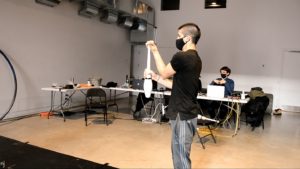
CirK 2.2 établit une connexion, une relation directe entre le mouvement, les acrobaties et les sonorités. Avec des capteurs sans fil, nous utilisons différents logiciels et algorithmes puissants qui reçoivent et analysent les données des capteurs. Ces données passent ensuite par différents processus qui les transforment en sons. Grâce à un “Feedback” en temps réel la musique et l’artiste interagissent ensemble. Les mouvements mais aussi les accessoires de cirque “s’expriment” à l’aide d’une technologie performante et interactive; les arts du cirque et la musique ne font plus qu’un.
Bobby Cookson, artiste spécialisé en Roue Cyr, ayant fait partie de l’expérimentation, s’exprime en ces termes:
“Mon cerveau voyageait entre l’artiste de cirque et le musicien. En plus de créer avec la roue Cyr, je me suis retrouvé à créer une mélodie comme je l’aurai fait avec un instrument de musique. J’ai eu la sensation de jouer avec un orchestre en direct, toujours à mon propre rythme”
L’idée est d’établir un cadre où le public puisse vivre une toute nouvelle expérience et aborder les arts du cirque d’une manière inédite. En plus de l’observer, il pourra aussi l’entendre, la ressentir et interagir d’une manière tout à fait nouvelle où “la musique se regarde et le mouvement s’écoute”.
Ce projet se veut créer des propositions artistiques qui vont au-delà de simples numéros de cirque; une expérience à part entière, à la frontière d’un concert et d’un spectacle de cirque avec une dimension multi-sensorielle au cœur de l’intention artistique.

Ruth Wikler comme spectatrice nous partage ses ressentis : “En tant que directrice adjointe de la programmation cirque à la TOHU, j’ai le privilège (et surtout pendant la pandémie!) de découvrir les idées les plus récentes des artistes et compagnies de cirque contemporaines montréalaises, au fur et à mesure qu’elles émergent de nos résidences de création. Naël Jammal fait partie de ces artistes de cirque dont la curiosité et l’imagination le propulsent dans des directions fascinantes. En faisant appel à ces nouvelles technologies, la recherche de Naël … représente bien plus qu’un simple “gadget”. En effet, le fait que tout type de son peut être attaché aux capteurs, cette recherche ouvre tout un nouveau langage scénique. Cela m’a fait penser à “Isadora” du monde de la danse, qui a également été créée par des artistes, pour des artistes. Les deux projets utilisent les nouvelles technologies, qui élargissent les champs du possible.”
Maintenant que la recherche a été faite pour deux ou trois disciplines de cirque, il y a pour moi, deux axes d’approche pour le suite.La première consiste à appliquer le travail réalisé avec une approche plus artistique, en travaillant sur différents sons, textures et effets pour répondre à différents concepts de création de numéros et dans le futur de spectacles.D’un autre côté, je souhaite poursuivre la recherche sur d’autres disciplines de cirque pour continuer à en mesurer tout le potentiel.
Je suis actuellement à la recherche de différents types de partenariats, pour poursuivre ce travail, notamment résidences de création, collaborateurs, soutien financier ou autre.
Je serais très heureux d’échanger avec vous, si vous êtes curieux d’en savoir plus. Vous pouvez me contacter en visitant mon profil ici.
Directeur de Projet - Naël JAMMAL Artistes Bobby Cookson - Roue Cyr Santiago Riviera - Jonglerie Naël JAMMAL - Jonglerie Conception des technologies interactives Son / Mouvement : Navid Navab Conception Sonore: Navid Navab + Peter van Haaften Conception Technique: Navid Navab + Evan Montpellier Développement et logiciel: Navid Navab + Evan Montpellier + Peter van Haaften Fabrication, modèles 3D, impressions 3D : Garnet Willis Design et prototypage conçus en collaboration avec: Centre de recherche, d'innovation et de transfert en arts du cirque (CRITAC) - École Nationale de Cirque Avec l'apport de: Les 7 Doigts
Photo principale 1: Bobby Cookson à la roue Cyr et Peter Van Haaften travaillant au mieux pour accorder le son en lien avec le mouvement.Editor's Note: At StageLync, an international platform for the performing arts, we celebrate the diversity of our writers' backgrounds. We recognize and support their choice to use either American or British English in their articles, respecting their individual preferences and origins. This policy allows us to embrace a wide range of linguistic expressions, enriching our content and reflecting the global nature of our community.
🎧 Join us on the StageLync Podcast for inspiring stories from the world of performing arts! Tune in to hear from the creative minds who bring magic to life, both onstage and behind the scenes. 🎙️ 👉 Listen now!
